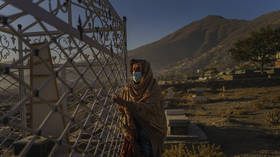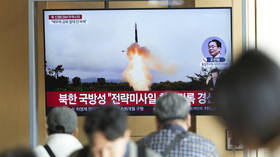Sickening 300% rise in civilian casualties shows Afghanistan still has nothing to show for 20 years of US warmongering

Despite American troops packing their bags in Afghanistan, the death toll of innocent people is increasing at an alarming rate. The country has paid a heavy price for two decades of conflict, and will continue to do so.
It’s been almost 20 years now since the United States and its allies entered Afghanistan as part of the ‘war on terror’, but even after all that time, it shows no signs of ending.
Nor, arguably, has there been any respite for Afghanistan’s people, despite a commitment towards peace between Washington and the Taliban. A new report authored by the Costs of War Project at Rhode Island’s Brown University found that deaths of civilians in the country caused by American and allied forces had increased by 300 per cent in the past three years.
Also on rt.com By failing to withdraw ALL forces from Afghanistan, Trump has killed the Afghan peace planThe study attributes the spike in casualties to the US relaxing its rules of engagement, as well as pressurising the Taliban – in line with Afghanistan’s Air Force – in an attempt to force it to negotiate. At the root of it all lies President Trump’s vision to withdraw US forces from the country, a move that is gathering momentum despite the fact the Taliban continues to attack and gain ground.
One might wonder, what’s next? This is a quagmire that offers no easy answers, with no end in sight. Not only are the insurgents never going to be defeated and the prospect of co-existence with the Afghanistan government remains remote, but more or less intervention by the US will serve only to intensify the conflict. The ordinary people of this country are the ultimate losers either way. Despite the fanatical nature of Taliban rule, has any US action in the past 20 years done them any favours? It would appear not.
Following the horrific 9/11 attacks in New York City in 2001, the Taliban-dominated Islamic Emirate of Afghanistan became a target of the US for regime change due to its perceived sympathy to Al-Qaeda and Osama Bin Laden, who was thought to be present in the country.
Washington believed the continued existence of the state was a national security threat, and subsequently launched Operation Enduring Freedom with its allies in an effort to remove the Taliban and restore its internationally recognized government.
However, it soon became clear that this planned liberation would be no walk in the park. Afghanistan remained to all intents and purposes a failed state, one reliant on the life support of the US and its allies. In the midst of chaos, poverty, and continued disorder, the Taliban had far more local legitimacy than had been bargained for. Far from being defeated, it rebranded as an insurgency force dedicated to driving out ‘foreign occupiers’ in the country, and has persisted with this role ever since.
With the Taliban’s roots being organic, three presidential administrations have tried and failed to defeat or placate it. The Trump White House, however, decided enough was enough, and in line with the president’s ‘America first’ policy of ending unnecessary troop deployments, vowed to take the US out of Afghanistan.
But in order to do so, the Taliban problem had to be resolved, which is why the rules of engagement were subsequently relaxed and civilian deaths soared. The White House sought to deal with the Taliban by attempting to bomb it out of existence, and reduce US casualties on the ground at the same time.
It didn’t work, but that hasn’t changed Trump’s determination to leave. The US brokered an agreement in Qatar earlier this year which tied America’s departure as conditional to efforts to secure a broader peace agreement, but Taliban attacks have continued regardless.
As Washington packs its bags and the balance of power changes, Afghanistan’s forces have been left to pick up the pieces, which has resulted in a further surge in civilian deaths. The ramifications of this are broader discontent and radicalization, which empowers the Taliban even more.
This pace of withdrawal has led to criticism of the Trump administration, with commentators arguing that the president is “handing Afghanistan to the Taliban.” But is there truly a winning solution?
Despite all the criticism of the Taliban’s ultra-fanatical Islamist rule, nearly 20 years of warmongering has brought no benefit to Afghanistan. Intervention has transformed the country into a crucible of destruction, carnage and chaos, and America’s decision to cut its losses there is long overdue. But the damage has already been done, and it would appear that there are no favourable outcomes that lie ahead.
Like this story? Share it with a friend!
The statements, views and opinions expressed in this column are solely those of the author and do not necessarily represent those of RT.













